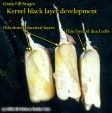

![]() he End-of-Season Cornstalk Test, developed at Iowa State
University (Blackmer & Mallarino, 1996), allows growers to conduct a
“post-mortem” evaluation of the adequacy of their nitrogen program
for the current growing season. The test is described as
“post-mortem” because stalk samples are taken after the grain is
physiologically mature. Given that this is a very late season test, the
interpretation of the results offers no assistance in fine-tuning nitrogen (N)
management for the current year, but rather provides insight into N management
options for coming years.
he End-of-Season Cornstalk Test, developed at Iowa State
University (Blackmer & Mallarino, 1996), allows growers to conduct a
“post-mortem” evaluation of the adequacy of their nitrogen program
for the current growing season. The test is described as
“post-mortem” because stalk samples are taken after the grain is
physiologically mature. Given that this is a very late season test, the
interpretation of the results offers no assistance in fine-tuning nitrogen (N)
management for the current year, but rather provides insight into N management
options for coming years.
The basis for the test lies in the fact that corn plants deficient for nitrogen will usually remobilize stored N from the lower portions of the stalk and leaves to the developing grain; resulting in lower stalk nitrogen concentrations at the end of the season. Plants that take up excessive amounts of soil nitrogen (more than is needed for maximum yields) will store excessive amounts in the lower stalk sections by the end of the growing season; resulting in higher stalk nitrogen concentrations.
The stalk nitrate test is probably best suited for identifying fields/situations where soil nitrogen uptake was excessive (no yield benefit) and, thus, costly to the grower and possibly the environment. Typical situations where N uptake may be excessive include manured fields or fields following alfalfa that received additional (and possibly unnecessary) nitrogen fertilizer applications for the subsequent corn crop. Some growers may be particularly interested in evaluating the adequacy of their N management program this year given the occurrence of multiple “monsoon” events that likely caused significant soil nitrate-N loss and nitrogen deficiency in the corn crop.
The procedure for collecting stalk samples is fairly straightforward and
reasonably speedy to perform in the field (Blackmer & Mallarino, 1996). Typically, samples should be
collected one to three weeks after 80% of the kernels reach the kernel black
layer stage (physiological maturity).
 Some fields throughout
the state are mature now, but many more will reach that point of development
over the next several weeks. If you are unfamiliar with staging kernel
development in corn, click on the image of the split kernels or take a look at
my article on the subject (Nielsen, 2002).
Some fields throughout
the state are mature now, but many more will reach that point of development
over the next several weeks. If you are unfamiliar with staging kernel
development in corn, click on the image of the split kernels or take a look at
my article on the subject (Nielsen, 2002).
Aim to sample areas within fields using spatial patterns similar to how you would collect soil samples. Within each area of the field, collect individual stalk segments from fifteen representative plants as outlined below. Each group of 15 stalk segments will be combined into a single sample for that area of the field.

The results of the analytical tests for stalk nitrate content are usually reported in terms of parts per million (ppm) nitrate-N and their interpretation is fairly simple. Recognize, though, that the results merely indicate whether nitrogen uptake itself was inadequate, adequate, or excessive relative to the nutrient needs of the crop in the current growing season. The following categories for stalk nitrate values are based on field calibration research trials conducted across Indiana in 1996 and 1997 (Brouder, 2003a) and differ slightly from those published by Blackmer & Mallarino (1996).
The true value of this test comes from repeated observations over years for a given field. If a field regularly tests in the optimal range (450 – 2000 ppm), the grower’s nitrogen program is evidently performing well. If a field is regularly identified as being low or inadequate (less than 450 ppm), then additional N fertilizer amounts may be justified in future years. Fields that regularly exhibit stalk nitrate values in the excessive category (greater than 2000 ppm) are likely candidates for lower investments in N fertilizer in future corn years. The use of the pre-sidedress soil nitrate test (Brouder & Mengel, 2003) may also be warranted for fields that regularly test in the excessive category for stalk nitrates in the fall.